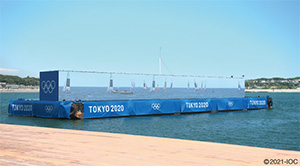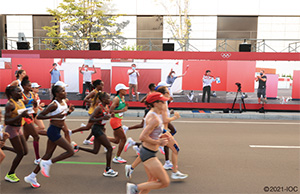 |
|||||||||
|
|
|||||||||
|
Feature Articles: Research and Development for Enabling the Remote World Vol. 20, No. 11, pp. 16–20, Nov. 2022. https://doi.org/10.53829/ntr202211fa1 Toward the Remote World in Which Life Is Many Times More Enjoyable¡½From ¡ÈRemote by Necessity¡É to ¡ÈRemote by Choice¡ÉAbstractThe novel coronavirus (COVID-19) pandemic has forced people to change their lifestyles and become remote. To enable people to choose a remote lifestyle or combine remote and real-world lifestyles so as to enrich their lives, NTT Human Informatics Laboratories is aiming to enable the Remote World unique to the post-pandemic era in two ways: (i) identifying and analyzing issues specific to new lifestyles from a wide range of perspectives including not only technology but also social science and humanities and (ii) promoting research and development regarding such issues. Keywords: Remote World, human augmentation, harmonic reproduction 1. A new lifestyle arrives: Remote WorldThe novel coronavirus (COVID-19) pandemic has drastically changed people’s lives and ways of thinking. One such change is the adoption of a remote lifestyle as epitomized by remote work, remote education, and remote sightseeing. Entering the year 2022, Europe and the US quickly regained their pre-pandemic lifestyles as real, face-to-face, offline activities become the norm again, which raises the question: Is remote lifestyle no longer necessary? Many people were forced to choose a remote lifestyle during the pandemic. However, after such experience, people concluded that what can be done remotely will be done remotely and enhance the real world and giving up is the only possibility if the only option is to participate in an activity in the real world; however, it is now possible to participate remotely. In other words, many people realized that by exploiting being remote, they can aim for a more fulfilling life, and by combining both real-world and remote lifestyles, they can increase opportunities for new experiences. We therefore predict that an era will come when people will actively and wisely choose with the mindset that some jobs or events are better in the real world, some are better in the remote world, and some are better in a combination of the real and remote worlds. When that era arrives, what will be required of the Remote World and the technologies that support them? We believe it is important to provide a remote lifestyle that offers unique value and user experiences that make people think that being remote has its unique advantages (Fig. 1).
When COVID-19 spread quickly throughout the world and had to be controlled as quickly as possible, we were suddenly forced to live a remote-centered life, and we were surprised and frustrated by the difference between the remote world and real world. The main requirement of technology was to resolve these issues and create a remote world with little difference from the real world and no sense of discomfort. At NTT Human Informatics Laboratories, we were among the first to tackle these issues, and in a very short period, we created a number of technologies and made achievements that have greatly contributed to the success of the international sports event held in Tokyo in 2021 by overcoming the challenging situation of holding the event behind closed doors and supporting spectators remotely. These achievements include providing a highly realistic sailing experience by using Kirari! (ultra-realistic communication technology) (Photo 1) and support for spectators remotely watching a marathon by connecting Sapporo and Tokyo using ultra-low-latency communication technology (Photo 2).
As of August 2022, the status of global COVID-19 infections, including Japan, has been steadily declining; however, it is expected to take a considerable amount of time before the disease is completely controllable like influenza. However, without a doubt, humankind will overcome this hardship and regain its pre-pandemic life. In fact, people’s desire to return to pre-pandemic life has become strong, especially in Europe and the United States. Under this circumstance, NTT Human Informatics Laboratories is anticipating a world in which this unprecedented situation comes to an end and people choose to be remote, as the occasion demands, to enrich their lives. We will research and develop technologies to mitigate dissatisfaction and discomfort in a society that is forced to be remote by necessity as well as technologies that enable people to be remote by choice i.e., choose a remote lifestyle or combine remote and real-world lifestyles. 2. Scenes in life where being remote is requiredWhat situations can be envisioned where the remote lifestyle can be applied? We envision the following situations. The first situation that comes to mind is work. The NTT Group is actively promoting remote work, and as an organization setting remote standards, we are further shifting to a remote-work-centered work style by which we basically use the home as the work place. Although it is relatively easy to shift to remote work for work using office automation equipment such as personal computers, it is not so easy to shift to remote work for work that involves both human and physical interactions. Equipment and facility maintenance and medical care are examples of tasks that are difficult to shift to remote work. If such tasks can be performed remotely, it would be possible to solve certain social issues such as (i) reducing energy consumed by cooling datacenters by locating them in cold regions (like the polar regions) and (ii) compensating for the shortage of nursing resources by allowing former registered nurses (who have left the nursing profession to raise children or other reasons) to perform nursing tasks remotely for short periods. The next situation to consider is education. During the COVID-19 pandemic, many places of learning were operated remotely, and problems such as a lack of communication between teachers and students and among students became apparent. However, it also became apparent that it is possible to have lessons even if the teacher and students are separated by considerable distance. For example, it is possible to receive instruction from an admired teacher regardless of distance and national borders. In such a remote-instruction situation, it is problematic when it is necessary to teach how to move the body, such as when playing a musical instrument or playing sports, because it is difficult to provide direct guidance using the current means of video-audio communication. To solve these problems and proactively use remote education and reap its benefits, it is essential to communicate—even remotely—the use of the body and body language. We also believe it is important to enhance leisure time, especially entertainment and sports. During the pandemic, every opportunity to experience the arts, such as concerts and plays, became remote; therefore, people have become dissatisfied over the loss of the live feeling and excitement compared with seeing the arts at venues and theaters. Such experiences, however, have shown that remote viewing is much easier to participate in because it is not restricted in terms of distance from the venue or seat availability. Some people like the remote viewing experience, which cannot be recreated in real life. Therefore, we believe that if performers and many spectators in remote locations can feel a sense of unity and excitement, and if this feeling can be created in a personal environment, it will further enrich leisure and hobby time. The same can be said about sports. If we can work up a sweat with like-minded people even when we are far from each other, we will have more opportunities to be physically active, and we can make ourselves and society as a whole healthier (Fig. 2).
3. Technologies supporting the Remote WorldThe Feature Articles in this issue introduce four technologies from among these various remote application scenarios: (i) human augmentation for transmitting motor skills and embodied knowledge of experts directly to people at a distance [1], (ii) telepresence technology for supporting remote interpersonal and interactive tasks [2], and (iii) harmonic reproduction technology [3] and (iv) emotional-perception-control technology [4] for creating a sense of unity and excitement between the venue audience and remote audience, and among remote audience members. As mentioned above, the world will eventually overcome this pandemic, even if it takes time. When that happens, we will not simply return to pre-pandemic life; instead, we will seek and obtain a new lifestyle—perhaps one that uses the knowledge we have gained over the past few years and one in which everyone can enjoy life many times more than before—by using real or remote styles or by combining the two. In collaboration with our partners, NTT Human Informatics Laboratories is aiming to achieve the Remote World unique to the post-pandemic era in two ways: (i) identifying and analyzing issues specific to new lifestyles from a wide range of perspectives including technology as well as social science and humanities and (ii) promoting research and development regarding such issues. References
|
|||||||||





